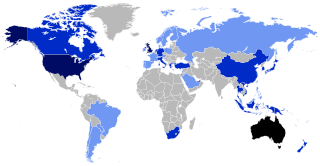
The population of Australia is estimated to be 27,152,400 as of 21 April 2024. Australia is the 56th most populous country in the world and the most populous Oceanian country. Its population is concentrated mainly in urban areas, particularly on the Eastern, South Eastern and Southern seaboards, and is expected to exceed 30 million by 2029.
Anglo-Celtic Australians is an ancestral grouping of Australians whose ancestors originate wholly or partially in the British Isles - predominantly in England, Ireland, Scotland and Wales, as well as the Isle of Man and Channel Islands.

Vietnamese Australians are Australians of Vietnamese descent. Vietnamese Australians are one of the largest groups within the global Vietnamese diaspora. At the 2021 census, 334,781 people stated that they had Vietnamese ancestry, representing 1.3% of the Australian population. In 2021, the Australian Bureau of Statistics estimated that there were 268,170 Australian residents who were born in Vietnam.

Sri Lankan Australians are people of Sri Lankan heritage living in Australia; this includes Sri Lankans by birth and by ancestry. Sri Lankan Australians constitute one of the largest groups of Overseas Sri Lankan communities and are the largest diasporic Sri Lankan community in Oceania. Sri Lankan Australians consist of people with Sinhalese, Tamil, Moor, Burgher, Malay and Chinese origins among others.

Lebanese Australians refers to citizens or permanent residents of Australia of Lebanese ancestry. The population is diverse, having a large Christian religious base, being mostly Maronite Catholics, while also having a large Muslim group of Sunni and Shia branches.
Sudanese Australians are people of Sudanese origin or descent living in Australia. The largest population of Sudanese Australians reside in Victoria (6,085).

Serbian Australians, are Australians of ethnic Serb ancestry. In the 2021 census there were 94,997 people in Australia who identified as having Serb ancestry, making it a significant group with the global Serb diaspora.
Iranian Australians or Persian Australians are Australian citizens who are of Iranian ancestry or who hold Iranian citizenship.
Malaysian Australians refers to Malaysians who have migrated to Australia or Australian-born citizens who are of Malaysian descent. This may include Malaysian Chinese, Malays, Malaysian Indians, Orang Asal, mixed Malaysians and other groups.
Pakistani Australians are Australians who are of Pakistani descent or heritage. Most Pakistani Australians are Muslims by religion, although there are also sizeable Christian, Hindu and other minorities.

Australians, colloquially known as Aussies, are the citizens, nationals and individuals associated with the country of Australia. This connection may be residential, legal, historical or ethno-cultural. For most Australians, several of these connections exist and are collectively the source of their being Australian. Australian law does not provide for a racial or ethnic component of nationality, instead relying on citizenship as a legal status.

English Australians, also known as Anglo-Australians, are Australians whose ancestry originates wholly or partly in England. In the 2021 census, 8,385,928 people, or 33% of the Australian population, stated that they had English ancestry. It is the largest self-identified ancestry in Australia. People of ethnic English origin have been the largest group to migrate to Australia since the establishment of the Colony of New South Wales in 1788.
Laotian Australians, also known as Lao Australians, refers to Australians who have either migrated from Laos and/or have Lao ancestry. The first Lao people that came to live in Australia arrived through the Colombo Plan in the 1960s, which gave a number of Laotians the opportunity to live and study in Australia. The migration of the Lao commenced with the Indochinese refugee crisis in 1975 following communist regime takeovers. According to the 2016 Census, there are 10,402 Laos-born Australians with the majority residing in New South Wales.

Ethiopian Australians are immigrants from Ethiopia to Australia and their descendants. However, as Ethiopia is a multi-ethnic country with significant inter-ethnic tensions, not all individuals from Ethiopia accept the label "Ethiopian", instead preferring to identify by their ethnic group. In particular, various Oromo people use the term 'Oromo Australian' instead. In contrast, there are many individuals who prefer to label themselves as Ethiopian Australians. This is because they oppose labelling themselves based on their ethnicity as they see it as divisive and politicising their ethnic identity. This is common among the Amharic-speaking community along with ethnically mixed individuals, compared to others who stand by their ethnic identity.

Melbourne is Australia's largest city and has a diverse and multicultural population.

Singaporean Australians are Australians of Singaporean descent. As Singapore is a multi-racial country, a Singaporean Australian could either be of Chinese, Malay or Indian descent, the main races of Singapore. According to the 2006 Australian census, 39,969 Australians were born in Singapore while 4,626 claimed Singaporean ancestry, either alone or with another ancestry.
Somali Australians are citizens and residents of Australia who are of Somali ancestry.
Kenyan Australians are Australian citizens and residents of Kenyan origin and descent. They may be of indigenous African, European, or Indian heritage.
The 2016 Australian census was the 17th national population census held in Australia. The census was officially conducted with effect on Tuesday, 9 August 2016. The total population of the Commonwealth of Australia was counted as 23,401,892 – an increase of 8.8 per cent or 1,894,175 people over the 2011 census. Norfolk Island joined the census for the first time in 2016, adding 1,748 to the population.
Asian immigration to Australia refers to immigration to Australia from part of the continent of Asia, which includes East Asia, Southeast Asia, and South Asia.The first major wave of Asian immigration to Australia occurred in the late 19th century, but the exclusionary White Australia policy, which was implemented to restrict non-European immigration, made it difficult for many Asian immigrants to migrate to the country. However, with the passage of the Migration Act 1958, the White Australia policy began to be phased out and Asian immigration to Australia increased significantly. Today, Asian immigrants from a wide range of countries play an important role in the cultural and economic landscape of Australia.













